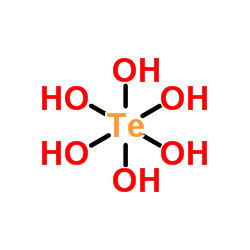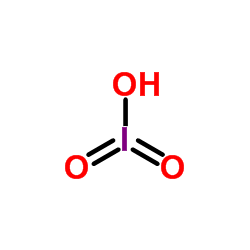7790-48-9
| 中文名 | 四碘化碲 |
|---|---|
| 英文名 | Tellurium tetraiodide |
| 中文别名 |
碘化碲
碘化碲(IV) |
| 英文别名 |
TELLURIUM(IV) IODIDE
EINECS 232-210-5 tellurium iodide tetraiodo-|E4-tellane MFCD00049578 Tellur(IV) iodid |
| 密度 | 5.05 g/mL at 25 °C(lit.) |
|---|---|
| 熔点 | 280°C |
| 分子式 | I4Te |
| 分子量 | 635.21800 |
| 精确质量 | 637.52400 |
| LogP | 3.16200 |
| 储存条件 | 保持贮藏器密封 放入紧密的贮藏器内,储存在阴凉,干燥的地方 |
| 稳定性 | 如果遵照规格使用和储存则不会分解 避免接触水分/潮湿。常温下即使在潮湿空气中也稳定,但加热时会分解出碘。在封管中的熔点为280℃,常压下当温度高于118℃时即开始升华并部分分解。可溶于氢碘酸,稍溶于丙酮和乙醇。在冷水中微微水解,加热则水解迅速。 |
| 计算化学 | 1.疏水参数计算参考值(XlogP):无 2.氢键供体数量:0 3.氢键受体数量:0 4.可旋转化学键数量:0 5.互变异构体数量:无 6.拓扑分子极性表面积0 7.重原子数量:5 8.表面电荷:0 9.复杂度:19.1 10.同位素原子数量:0 11.确定原子立构中心数量:0 12.不确定原子立构中心数量:0 13.确定化学键立构中心数量:0 14.不确定化学键立构中心数量:0 15.共价键单元数量:1 |
| 更多 | 1. 性状:青铜灰色结晶。在潮解空气中稳定。 2. 密度(g/mL 25ºC):5.05 3. 相对蒸汽密度(g/mL,空气=1):未确定 4. 熔点(ºC):280 5. 沸点(ºC,常压):未确定 6. 沸点(ºC,5.2kPa):未确定 7. 折射率(n20/D):未确定 8. 闪点(ºC,):未确定 9. 比旋光度(º):未确定 10. 自燃点或引燃温度(ºC):未确定 11. 蒸气压(kPa,25ºC):未确定 12. 饱和蒸气压(kPa,60ºC):未确定 13. 燃烧热(KJ/mol):未确定 14. 临界温度(ºC):未确定 15. 临界压力(KPa):未确定 16. 油水(辛醇/水)分配系数的对数值(25℃):未确定 17. 爆炸上限(%,V/V):未确定 18. 爆炸下限(%,V/V):未确定 19. 溶解性(mg/mL) :溶于氢碘酸、碱液和氨水,微溶于丙酮、乙醇和戊醇,几乎不溶于四氯化碳、二硫化碳、酯类和乙酸。 |
|
Section 1: Product Identification Chemical Name:Tellurium (IV) iodide (99.9%-Te) CAS Registry Number:7790-48-9 Formula:TeI4 EINECS Number:232-210-5 Chemical Family:metal halide Synonym:Tellurium tetraiodide.
Section 2: Composition and Information on Ingredients IngredientCAS NumberPercentACGIH (TWA)OSHA (PEL) Title Compound7790-48-9100%0.1mg/m3 (as Te)0.1mg/m3 (as Te) Section 3: Hazards Identification Causes severe skin, eye and respiratory tract irritation with cough, breathing difficulty, nausea and vomiting. Emergency Overview: Prolonged exposure may produce a mild toxic syndrome known as iodism. Primary Routes of Exposure:Contact with skin and eyes. Inhalation of dust. Eye Contact:Causes redness, pain, and blurred vision. Splashes from solutions may cause eye damage. Skin Contact:Causes severe irritation, ulcerations, itching, pimples, boils, hives, blisters and skin burns. Inhalation:Causes irritation to the respiratory tract. Symptoms may include coughing and shortness of breath. Ingestion:May cause severe irritation to the gastrointestinal tract with abdominal pain, nausea, and vomiting. May cause coughing, nausea, and vomiting. Skin and eye contact will cause severe irritation. Tellurium may Acute Health Affects: cause garlic odor of breath, metallic taste, sleepiness, headache and nausea. Chronic ingestion of iodides may produce iodism. Symptoms include skin rash, running nose, headache and Chronic Health Affects:irritation of mucous membranes. Prolonged exposure to tellurium may cause drowsiness and loss of appetite. NTP:No IARC:No OSHA:No SECTION 4: First Aid Measures Immediately flush the eyes with copious amounts of water for at least 10-15 minutes. A victim may need Eye Exposure: assistance in keeping their eye lids open. Get immediate medical attention. Wash the affected area with water. Remove contaminated clothes if necessary. Seek medical assistance if Skin Exposure: irritation persists. Remove the victim to fresh air. Closely monitor the victim for signs of respiratory problems, such as difficulty Inhalation: in breathing, coughing, wheezing, or pain. In such cases seek immediate medical assistance. Seek medical attention immediately. Keep the victim calm. Give the victim water (only if conscious). Induce Ingestion: vomiting only if directed by medical personnel. SECTION 5: Fire Fighting Measures Flash Point:not applicable Autoignition Temperature:none Explosion Limits:none Extinguishing Medium:None. Material is non-flammable. Special Fire Fighting Procedures:No special fire fighting procedures required. Hazardous Combustion andnone Decomposion Products: Unusual Fire or Explosion Hazards: No unusual fire or explosion hazards. SECTION 6: Accidental Release Measures Small spills can be mixed with powdered sodium bicarbonate, lime, or calcium carbonate and swept up. Avoid Spill and Leak Procedures: raising dust. SECTION 7: Handling and Storage Store solid in a tightly sealed container away from moisture. Handle in a fume hood under a dry atmosphere of Handling and Storage: air or nitrogen. Prolonged exposure to the atmosphere may degrade the product. SECTION 8: Exposure Controls and Personal Protection Eye Protection:Always wear approved safety glasses when handling a chemical substance in the laboratory. Skin Protection:Wear protective clothing and gloves. Consult with glove manufacturer to determine the proper type of glove. Ventilation:Material may form a fine dust. If possible, handle the material in an efficient fume hood. If in form of fine dust and ventilation is not available a respirator should be worn. The use of respirators Respirator: requires a Respirator Protection Program to be in compliance with 29 CFR 1910.134. Ventilation:Material may form a fine dust. If possible, handle the material in an efficient fume hood. Additional Protection:No additional protection required. SECTION 9: Physical and Chemical Properties Color and Form:-4 mesh gran. Molecular Weight:635.22 Melting Point:280° Boiling Point:no data Vapor Pressure:no data Specific Gravity:5.403 Odor:none Solubility in Water:slightly soluble SECTION 10: Stability and Reactivity Stability:moisture sensitive Hazardous Polymerization:no hazardous polymerization Conditions to Avoid:contact with moisture Incompatibility:active metals Decomposition Products:none SECTION 11: Toxicological Information RTECS Data:No information available in the RTECS files. Carcinogenic Effects:no data Mutagenic Effects:no data Tetratogenic Effects:no data SECTION 12: Ecological Information Ecological Information:No information available SECTION 13: Disposal Considerations Disposal:Dispose of according to local, state and federal regulations. SECTION 14: Transportation Shipping Name (CFR):Non-hazardous Hazard Class (CFR):NA Additional Hazard Class (CFR):NA Packaging Group (CFR):NA UN ID Number (CFR):NA Shipping Name (IATA):Non-hazardous Hazard Class (IATA):NA Additional Hazard Class (IATA):NA Packaging Group (IATA):NA UN ID Number (IATA):NA SECTION 15: Regulatory Information TSCA:Listed in the TSCA inventory SARA (Title 313):Not reportable under SARA 313. Second Ingredient:none SECTION 16 - ADDITIONAL INFORMATION N/A |
|
毒理学数据: 有腐蚀性 生态学数据: 对水是稍微危害的,若无政府许可,勿将材料排入周围环境
|
| 危害码 (欧洲) | C |
|---|---|
| 风险声明 (欧洲) | 20/21/22-34 |
| 安全声明 (欧洲) | S22-S26-S27-S36/37/39-S45 |
| 危险品运输编码 | UN 3260 8/PG 2 |
| WGK德国 | 3 |
| 包装等级 | II |
| 危险类别 | 8 |
|
~% 
7790-48-9 |
| 文献:Ann. Chim. Phys., , vol. 58, p. 272 - 272 Annalen der Physik (Weinheim, Germany), , vol. 32, p. 619 - 619 |
|
~% 
7790-48-9 |
| 文献:Z. Anorg. Chem., , vol. 32, p. 110 - 110 |
|
~% 
7790-48-9 |
| 文献:Z. Anorg. Chem., , vol. 13, p. 169 - 169 |
|
~0%
详细
|
| 文献:Annalen der Physik (Weinheim, Germany), , vol. 32, p. 622 - 622 Z. Anorg. Chem., , vol. 32, p. 110 - 110 |
|
~% 
7790-48-9 |
| 文献:Bulletin de la Societe Chimique de France, , p. 886 - 888 Te: SVol.B1, 2.2.8.4, page 58 - 72 |
|
~% 
7790-48-9 |
| 文献:Inorganic Materials, , vol. 43, # 9 p. 1018 - 1023 |
|
~% 
7790-48-9 |
| 文献:Zeitschrift fuer Anorganische und Allgemeine Chemie, , vol. 461, p. 165 - 172 |
| 上游产品 8 | |
|---|---|
| 下游产品 5 | |












